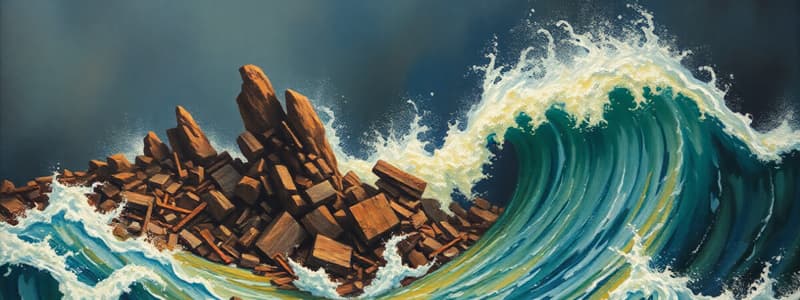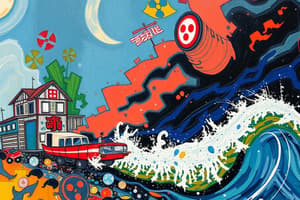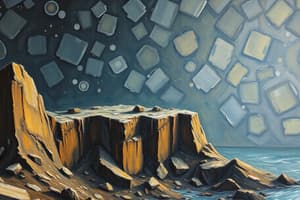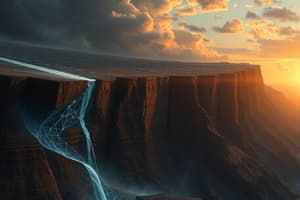Podcast
Questions and Answers
What primarily causes earthquakes?
What primarily causes earthquakes?
- Volcanic eruptions
- Atmospheric pressure changes
- Meteor strikes
- Tectonic plates slipping past each other (correct)
The epicenter of an earthquake is the same as the focus.
The epicenter of an earthquake is the same as the focus.
False (B)
What is the primary type of wave produced during an earthquake that travels the fastest?
What is the primary type of wave produced during an earthquake that travels the fastest?
P Waves
A __________ is a large wave caused by underwater earthquakes.
A __________ is a large wave caused by underwater earthquakes.
Match the following earthquakes and their corresponding tsunamis:
Match the following earthquakes and their corresponding tsunamis:
Which of the following is NOT a type of seismic wave?
Which of the following is NOT a type of seismic wave?
The outer core of the Earth is solid.
The outer core of the Earth is solid.
Who proposed the theory of Continental Drift?
Who proposed the theory of Continental Drift?
What type of volcano is considered unlikely to erupt again?
What type of volcano is considered unlikely to erupt again?
The oceanic crust is less dense than continental crust.
The oceanic crust is less dense than continental crust.
Name the three types of plate boundaries.
Name the three types of plate boundaries.
Magma is forced out of the Earth's crust at ________ boundaries.
Magma is forced out of the Earth's crust at ________ boundaries.
Match the types of volcanoes with their characteristics:
Match the types of volcanoes with their characteristics:
Where do most volcanoes form?
Where do most volcanoes form?
Sea floor spreading occurs at convergent boundaries.
Sea floor spreading occurs at convergent boundaries.
What are the differences between P, S, and L waves?
What are the differences between P, S, and L waves?
Flashcards
Earthquake Cause
Earthquake Cause
Earthquakes are caused by tectonic plates sliding past each other, releasing energy as seismic waves.
Epicenter
Epicenter
The point on Earth's surface directly above where an earthquake starts.
Tsunami Definition
Tsunami Definition
A large wave caused by underwater earthquakes, volcanic eruptions, or other major movements in Earth's crust.
Continental Drift Theory
Continental Drift Theory
Signup and view all the flashcards
P-waves
P-waves
Signup and view all the flashcards
S-waves
S-waves
Signup and view all the flashcards
2004 Indian Ocean Tsunami Cause
2004 Indian Ocean Tsunami Cause
Signup and view all the flashcards
Earth's Crust Layers
Earth's Crust Layers
Signup and view all the flashcards
Oceanic Crust
Oceanic Crust
Signup and view all the flashcards
Volcano Types
Volcano Types
Signup and view all the flashcards
Divergent Boundaries
Divergent Boundaries
Signup and view all the flashcards
Convergent Boundaries
Convergent Boundaries
Signup and view all the flashcards
Tectonic Plate Boundaries
Tectonic Plate Boundaries
Signup and view all the flashcards
Seafloor Spreading
Seafloor Spreading
Signup and view all the flashcards
Earth's Layers
Earth's Layers
Signup and view all the flashcards
Seismic Waves
Seismic Waves
Signup and view all the flashcards
Study Notes
Earthquakes
- Earthquakes are caused by tectonic plates slipping past each other, releasing energy as seismic waves.
- Epicenter: The point on Earth's surface directly above the earthquake's origin.
- Focus: The location within the Earth where the earthquake originates.
- Seismic waves:
- P waves (Primary waves): Fastest, compress and stretch rocks.
- S waves (Secondary waves): Slower than P waves, move rocks side-to-side.
- L waves (Surface waves): Most destructive, move in circular or up-and-down motions along the surface.
- Understand the 2004 Indian Ocean Earthquake and Tsunami (how, what, where, when).
- Understand the 2011 Tohoku Earthquake and Tsunami (how, what, where, when).
Tsunamis
- Definition: A large wave caused by underwater earthquakes, volcanic eruptions or other crustal movements.
- Historical Tsunamis:
- 2004 Southeast Asian tsunami: A 9.0 magnitude earthquake caused widespread devastation.
- Krakatau eruption (1883): Triggered a massive tsunami.
Plate Tectonics and Continental Drift
- Continental Drift Theory: Continents were once connected in a supercontinent called Pangaea.
- Evidence for Continental Drift:
- Similar fossils and mountain ranges found on now-separated continents.
- Matching glacial features across continents.
Structure of the Earth
- Layers:
- Crust: Outermost layer (continental and oceanic).
- Mantle: Below the crust, composed of hot, semi-liquid rock (magma).
- Core: Hottest part, divided into inner (solid) and outer (liquid) core.
- Types of Crust:
- Continental
- Oceanic (denser than continental).
- Diagram: Understand the structure and each layer's properties.
Volcanoes
- Locations: Primarily at tectonic plate boundaries (especially the Ring of Fire).
- Types by Activity:
- Extinct: Unlikely to erupt again.
- Dormant: Not currently active but may erupt in the future.
- Active: Showing signs of or currently erupting.
- Magma formation: Formation at tectonic boundaries, and volcanic eruptions.
Plate Boundaries
- Types of Plate Boundaries:
- Divergent: Plates move apart, creating new crust.
- Convergent: Plates collide, leading to subduction, mountain formation, or volcanic activity,
- Transform: Plates slide past one another.
- Sea Floor Spreading: Hot magma rises at mid-ocean ridges, creating new crust and pushing continents apart.
Study Tips
- Understand key terms (epicenter, focus, tsunami, continental drift, Ring of Fire).
- Be able to label and explain Earth's layers (crust, mantle, core) on a diagram.
- Be familiar with historical events, such as the 2004 tsunami and the 1883 Krakatoa eruption.
- Understand differences between wave types (P, S, L waves).
- Practice labeling diagrams and review key topics from the slides.
- Practice multiple choice, true/false, and short answer questions.
Studying That Suits You
Use AI to generate personalized quizzes and flashcards to suit your learning preferences.




